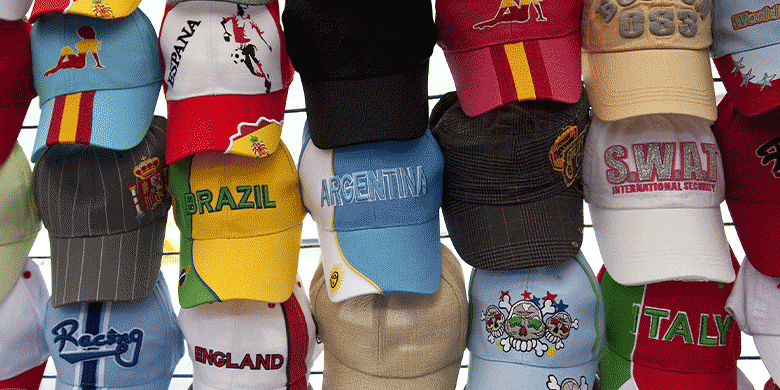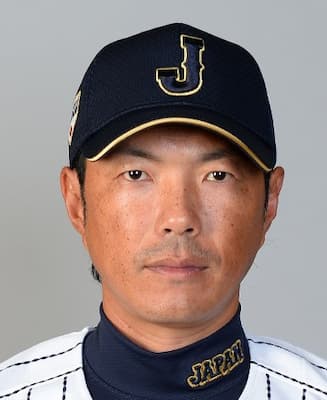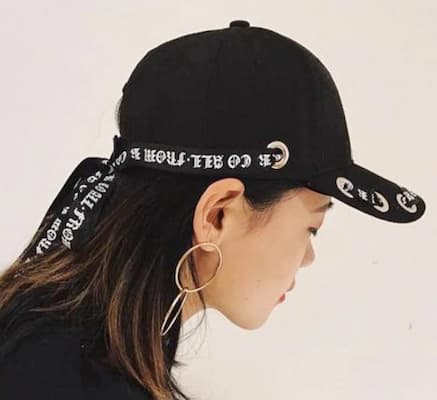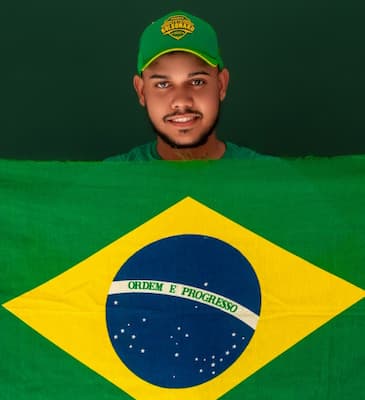
13 October, 2023
A Global Hat Trip to Baseball Caps Around The World
The baseball cap: an iconic headwear piece that transcends borders. While it finds its roots in America's favorite pastime, the baseball cap has been embraced, adapted, and redefined by various countries and cultures around the globe. Whether it's a symbol of style, a practical accessory, or a badge of identity, the cap's universality is undeniable. Let's embark on a journey exploring how different countries and cultures have put their spin on this classic hat.
United States: Birthplace and Trendsetter

In the sprawling fields of 19th-century America, as baseball emerged as a favourite pastime, players found themselves squinting against the bright sun. The introduction of the baseball cap, with its distinctive forward-facing brim, became an immediate solution. Initially just a practical piece of the uniform, this cap would go on to capture the essence of American culture in ways few could have predicted.
America, ever the melting pot of innovation, didn't just stop at the traditional cap. Instead, the U.S. birthed multiple iterations:
Snapbacks: Born out of a need for adjustability, the snapback brought a whole new level of convenience to caps. With their flat brims and snapping mechanism at the back, snapbacks allowed wearers to adjust the hat's fit to their liking. This cap became a cultural sensation, adorning the heads of hip-hop artists, skateboarders, and many youth in urban centers.
Trucker Hats: These started off as promotional giveaways by U.S. farming supply companies to truckers and rural workers. Recognised by their mesh back panels, they provided ventilation — a practical solution for long hours on the road. However, by the early 2000s, this once-utilitarian hat became a significant fashion trend, embraced by celebrities and the general public alike.
In the world of baseball caps, few names are as revered as New Era and '47. New Era's 59FIFTY, often referred to as the "fitted" cap, became the gold standard for professional baseball players. With its structured design and flat brim, it quickly transitioned from the baseball diamond to the streets, becoming a cultural symbol of style and allegiance.
'47, on the other hand, took a more vintage approach, blending contemporary styles with classic designs. Their caps, often showcasing throwback logos and softer structures, struck a chord with those wanting both comfort and nostalgia.
One of the most defining characteristics of baseball caps in the U.S. is how they've become badges of identity. Sports enthusiasts wear them to show their unwavering support for their favourite teams. Beyond sports, caps became markers of regional pride, with city skylines or state symbols stitched onto them. Furthermore, the political arena wasn't left untouched. From campaign slogans to movements championing social causes, baseball caps have become canvases for advocacy and expression.
The journey of the baseball cap in the U.S. is a testament to America's ability to constantly reinvent and redefine. From its humble beginnings on the baseball field to its paramount status in fashion and cultural statements, this cap is undeniably a symbol of the American spirit — versatile, adaptive, and ever-evolving.
Japan: A Fusion of Tradition and Modernity

Baseball, introduced to Japan in the late 19th century, became more than just a sport; it turned into a cultural phenomenon. As the game's popularity soared, so did the adoption of its attire. Japanese baseball teams, each with its passionate fanbase, released team-specific caps that became sought-after collectibles. But what set Japanese baseball caps apart was not just the logos of the famed teams like the Yomiuri Giants or the Hanshin Tigers; it was the quality of craftsmanship, representing Japan's meticulous attention to detail.
Japan's street fashion is renowned for its innovative take on global trends, creating a nostalgic and avant-garde blend. And when it comes to baseball caps, this fusion is particularly evident.
BAPE (A Bathing Ape): Founded by Nigo in Tokyo, BAPE transformed streetwear with its iconic camouflage patterns and ape logo. Their baseball caps, often featuring camo designs mixed with traditional Japanese symbols like the "Maneki-neko" (beckoning cat) or "Koi" (carp), are testament to Japan's knack for merging the past with the present.
COMME des GARÇONS: Led by the enigmatic Rei Kawakubo, COMME des GARÇONS is less about streetwear and more about high fashion that challenges norms. Their interpretation of the baseball cap is no exception. At times, they've integrated the cap into their collections, experimenting with materials like felt or leather and often adding traditional motifs, such as sakura (cherry blossom) embroideries or contemporary patterns.
What makes Japanese baseball caps truly stand out is their incorporation of centuries-old motifs into modern designs. Whether it's the fierce and mythical "Ryu" (dragon), serene "Fuji-san" (Mount Fuji) landscapes, or the delicate petals of "Ume" (plum blossoms), these symbols tell tales of Japan's rich history and beliefs. Additionally, certain designs might incorporate Japanese calligraphy, "Kanji" or "Hiragana" characters, not just as aesthetic additions but often conveying deeper messages or wishes for the wearer.
Baseball caps have found a unique place in Japanese fashion in the bustling streets of Tokyo or the serene pathways of Kyoto. They are not just accessories but narrative pieces, telling tales of a nation that respects its roots while eagerly looking to the future. In Japan, it is more than a headwear item; it's a canvas where tradition meets modernity, and age-old tales blend seamlessly with contemporary flair.
South Korea: K-Pop's Stylish Stamp

K-Pop, South Korea's vibrant music industry, has conquered the hearts of fans globally and shaped and defined trends within the nation. What K-Pop idols wear often becomes a massive trend, and baseball caps, versatile and chic, have found themselves prominently featured in this cultural tapestry.
In South Korea, where K-Pop idols are often seen as the epitome of youth and trendsetting, baseball caps have become synonymous with youthful exuberance. These caps, when worn slightly tilted or backwards, offer a rebellious charm that contrasts beautifully with the structured aesthetic often seen in traditional Korean attire.
Often, you'd find idols sporting plain black or white caps with no logos, offering a neutral accessory that complements their statement outfits. This minimalist trend has trickled down to the masses, with many young Koreans opting for these simple yet stylish caps.
Making use of South Korea's beautiful script, many feature bold Hangul lettering, sometimes spelling out the name of the K-Pop group, a popular song title, or even phrases that resonate with the youth. It's a unique blend of linguistic pride and fashion. Some of the most popular caps are adorned with logos of K-Pop bands or their record labels. Fans often wear these as badges of honour, showcasing their allegiance to their favourite artists.
Many K-Pop artists and groups collaborate with fashion brands, leading to exclusive cap collections. These often sell out within minutes of release, testament to their popularity. Such collaborations blend the artistic ethos with the brand's design sensibilities, resulting in unique and sought-after pieces.
In the buzzing streets of Seoul, where modern skyscrapers stand tall beside centuries-old palaces, baseball caps have emerged as symbols of modern South Korean identity, deeply influenced by the nation's global music phenomenon - K-Pop. They signify more than just a trend; they represent a nation's youth's voice, aspirations, and unyielding spirit.
Australia: Surf, Sun, and Sports

Australia, a vast expanse of diverse landscapes, from golden beaches to rugged outback, has a strong outdoor culture. With its ample sunshine and plethora of sporting events, the baseball cap finds itself not just as a fashion accessory but a functional piece of gear, vital for the Aussie outdoor lifestyle.
Australia's coastlines are adorned with some of the world's most famous beaches. Surfing, a sport deeply embedded in the Aussie way of life, sees baseball caps as an essential accessory. Whether it's a quick game of beach cricket, a surf check at Bondi Beach, or a laid-back afternoon at a Gold Coast cafe, the cap is as ubiquitous as the waves themselves.
While baseball might not be the dominant sport in Australia, the cap associated with it has seamlessly integrated into other sporting arenas. Cricket, the summer sport of choice, sees players and spectators donning baseball caps and the Baggy Green cap has literally entered folklore. The caps offer protection against the fierce Australian sun, especially during long test matches or exhilarating T20 games.
Local Australian brands often draw from the rich tapestry of the nation's history, culture, and landscapes in their design ethos.
Indigenous Inspiration: Some brands work collaboratively with Indigenous artists, resulting in caps adorned with intricate Aboriginal dot paintings or symbols, telling tales of Dreamtime and the connection to the land.
Aussie Flora and Fauna: The unique biodiversity of Australia provides ample inspiration. It's common to find caps embroidered with kangaroos, koalas, or floral motifs like the golden wattle, Australia's national flower.
Local Lingo and Landmarks: Caps that sport colloquial Aussie phrases or iconic landmarks like the Sydney Opera House, the Great Barrier Reef, or Uluru make them particularly popular among both locals and tourists.
The Functional Curve: Sun Safety First
Australia's position under the ozone hole means sun safety is paramount. The curved brim of the baseball cap is a preferred design, offering enhanced protection against harmful UV rays. This functional design aspect is a clear nod to the practical Aussie spirit, merging need with style.
In Australia, it isn't just an accessory; it's an emblem of a lifestyle deeply connected to the outdoors. Whether it's the roaring surf, the thrill of sports, or the relaxed ambiance of a barbecue with mates, the cap is a testament to Australia's sunny disposition and adventurous spirit.
United Kingdom: Casual and Couture

When baseball caps first appeared in the UK, they were primarily associated with their American roots. The cap was emblematic of American sports and youth culture to many Brits. However, as time progressed and globalisation merged fashion lines, the cap started evolving, drawing from Britain's rich cultural and fashion history.
The streets of London, Manchester, and other UK cities have always been breeding grounds for diverse subcultures, from punk to mod and grime. Initially an outsider, the baseball cap soon found acceptance and adaptation within these groups. Grime artists began incorporating baseball caps into their looks, adding a distinctly British touch to their outfits.
Several British designers recognised the potential of the baseball cap as a canvas for artistic expression:
Plaid and Tartan Twists: Synonymous with British fashion, plaid, especially patterns like the classic Burberry check, began adorning them, transforming them from casual wear to fashion statements.
Embroidered Crests and Symbols: Drawing from the tradition of family crests and the rich British history, designers began embroidering with various symbols. Lions, roses, and even reinterpretations of the royal coat of arms found their way onto these caps.
Luxury Materials: The British have always had a penchant for luxury, and their caps were no exception. High-end versions crafted from leather, suede, or tweed began appearing, marrying the cap's casualness with opulent materials.
The definitive sign that the baseball cap had found its footing in UK fashion was its presence in the country's esteemed fashion weeks. Models strutted down runways, their outfits complemented by caps that ranged from minimalist to ornate. This not only solidified the baseball cap's place in British fashion but also showcased the versatility and adaptability of this accessory.
The journey of the baseball cap in the UK is a testament to the country's ability to take an external influence and make it inherently British. From its initial identity as an American sportswear item to its reinvention as a staple of British fashion, it stands as a symbol of the dynamic and evolving nature of UK's fashion landscape.
Latin America: Caps with Cultural Flair

In the tapestry of Latin America, where vivid colours, passionate football fans, and age-old traditions intertwine, the baseball cap emerges as a canvas, capturing stories from different corners of the continent.
In a region where football (soccer) is more than just a sport - it's a religion - baseball caps take on a distinct role. Argentina's Boca Juniors, Brazil's Flamengo, Mexico's Chivas: the names of these football clubs are not just chanted in stadiums but are worn with pride on caps. They symbolise allegiance, not just to a team but to a community and a shared history.
One can't think of Latin America without picturing its kaleidoscope of festivals, from Brazil's Carnival to Mexico's Day of the Dead. These cultural festivities, bursting with colours and motifs, spill over into the design. Brazilian caps often echo the vibrant colours of its Carnival – brilliant greens, yellows, and blues, sometimes adorned with sequins, mirroring the country's vivacious spirit.
Countries like Peru and Bolivia, with their rich indigenous cultures, reflect ancient motifs. Inspired by the Incas or Aztecs, geometric patterns find their way onto these headgears, turning them into wearable pieces of history.
Beyond football and festivals, in Latin America, they often serve as banners of national pride. Be it the Argentine sun or the Chilean star, national symbols often get embroidered onto caps, turning them into emblems of patriotism. In vast nations like Brazil or Mexico, caps become markers of regional identity. One sporting patterns from Oaxaca might differ vastly from one inspired by the Yucatán Peninsula, reflecting the rich tapestry of regional cultures within countries.
In Latin America, it is not a mere accessory; it's an emblem, a statement, a story. By weaving together threads of history, sports, tradition, and contemporary fashion, the region has taken an American classic and infused it with a distinctly Latin soul, making it as diverse and dynamic as the lands from which it draws inspiration.
Conclusion
The baseball cap's journey from American baseball fields to global ubiquity is a testament to its versatility and universal appeal. As it travels, it absorbs local flavors, becoming a canvas for cultural expression and personal identity. Whether it's worn for style, sport, or shade, the baseball cap is a global citizen, uniting us in its curved brim embrace.
The Caps Only Team

